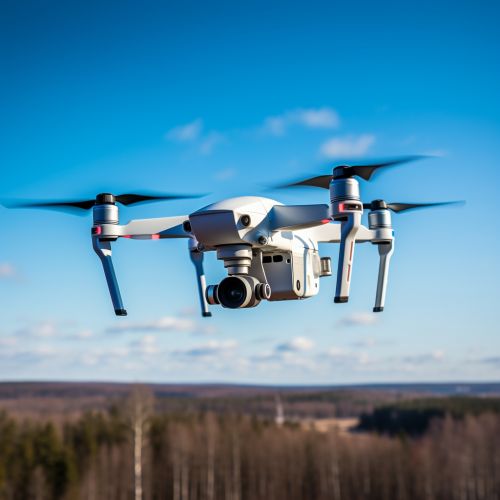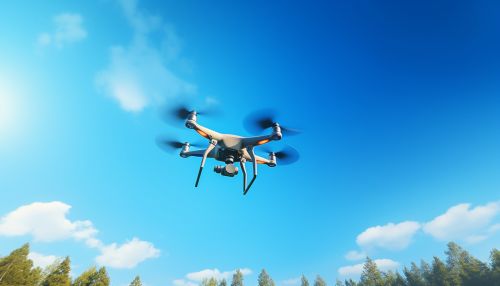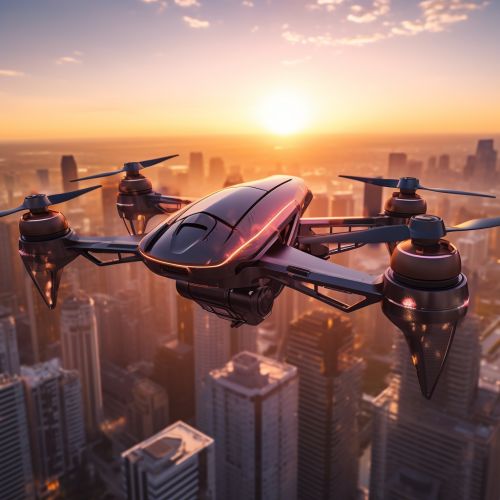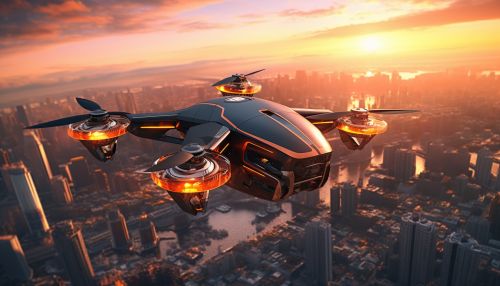Drone photography
Introduction
Drone photography refers to the capturing of still images and video by a remotely-operated or autonomous unmanned aerial vehicle (UAV), also known as an unmanned aircraft system (UAS) or, more commonly, as a drone. The advent of drone photography has revolutionized the field of photography by enabling the capture of images from vantage points that were previously inaccessible. It has found applications in various fields, including real estate, construction, filmmaking, and agriculture, among others.


History
The history of drone photography can be traced back to the early 20th century when the first aerial photographs were taken from unmanned balloons and kites. The development of radio-controlled (RC) aircraft in the mid-20th century opened new possibilities for aerial photography. However, it was not until the early 21st century, with the advent of small, affordable, user-friendly drones, that drone photography became a widespread phenomenon.
Types of Drones Used in Photography
There are several types of drones used in photography, each with its unique characteristics and applications. The most common types include multi-rotor drones, fixed-wing drones, and single-rotor helicopters.
Multi-rotor Drones
Multi-rotor drones are the most common type of drone used in photography and videography. These drones are known for their stability in flight, which is crucial for capturing high-quality images and videos. They are typically equipped with advanced flight control systems and multiple propellers that allow for precise positioning and maneuverability.
Fixed-wing Drones
Fixed-wing drones, unlike multi-rotor drones, have a single rigid wing that spans across the body of the drone. These drones are capable of covering long distances and staying aloft for extended periods, making them ideal for large-scale aerial photography, such as landscape and wildlife photography.
Single-rotor Helicopters
Single-rotor helicopters are less common in photography but offer certain advantages over multi-rotor drones. They are capable of longer flight times and can carry heavier payloads, which is beneficial when using high-end camera equipment.
Drone Photography Techniques
There are several techniques that photographers use to capture unique and compelling images with drones. These include top-down shots, panorama, the "dronie," and the reveal, among others.
Top-down Shots
Top-down shots, also known as bird's-eye view shots, are captured by positioning the drone directly above the subject and pointing the camera downwards. This perspective can create unique and abstract images that are not possible with traditional photography methods.
Panorama
Panorama shots involve capturing multiple images from different angles and then stitching them together to create a wide-angle or 360-degree view of the scene. This technique is particularly useful for landscape and cityscape photography.
The "Dronie"
The "dronie" is a type of selfie taken with a drone. It typically involves the drone starting close to the subject and then flying backwards and upwards to reveal the surrounding landscape.
The Reveal
The reveal is a cinematographic technique where the drone starts with a close-up of a subject and then gradually moves backwards to reveal the larger context or landscape.
Applications of Drone Photography
Drone photography has a wide range of applications across various industries. Some of the most prominent applications include real estate photography, construction site monitoring, agriculture, and filmmaking.
Real Estate Photography
In real estate, drone photography is used to capture aerial views of properties, providing potential buyers with a unique perspective of the property's size, layout, and surroundings.
Construction Site Monitoring
In construction, drones are used to monitor the progress of projects, inspect structures, and provide documentation for clients. The high-resolution images and videos captured by drones can help identify potential issues and improve efficiency on construction sites.
Agriculture
In agriculture, drones are used to capture detailed images of crops, helping farmers monitor the health of their crops, identify issues, and optimize crop yield.
Filmmaking
In filmmaking, drones are used to capture aerial shots and unique perspectives that were previously difficult or expensive to achieve. Drones have revolutionized the way filmmakers approach cinematography, providing them with more creative freedom.
Legal and Ethical Considerations
As with any technology, drone photography comes with its set of legal and ethical considerations. In many countries, drone operators are required to obtain a license or permit to operate a drone for commercial purposes. There are also restrictions on where drones can be flown, with many countries prohibiting drone flight in certain areas, such as near airports or over private property.
From an ethical perspective, issues such as invasion of privacy and disturbance to wildlife are of concern. Drone photographers are encouraged to respect the privacy of individuals and to avoid disturbing wildlife when operating drones.
Future of Drone Photography
The future of drone photography looks promising, with advancements in drone technology and imaging equipment expected to open up new possibilities for aerial photography. Developments in artificial intelligence and machine learning are also expected to play a significant role in the future of drone photography, with potential applications in image recognition, automated flight, and data analysis.


